Setubalense
Until it was absorbed by TST in 2006, Setubalense operated from its base in the city of Setúbal, on the River
Sado, to the south of the Tagus, Setubalense running services
to a variety of Lisbon termini. Its services can also be seen at Cacilhas.
3: Oriente Bus Interchange
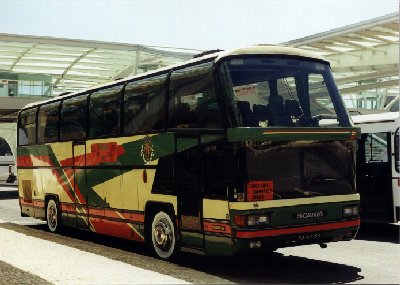
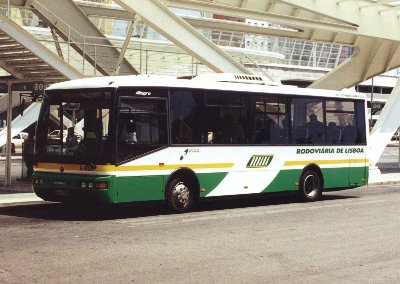
L to R: A service to Guimarães in northern Portugal; a suburban service operated by a Dennis bus of Rodoviária de Lisboa.
Situated on the landward-side of the Oriente railway station complex, this is a large, modern facility. Like the railway station, the booking offices are situated at a higher level than the services and is also poorly signposted. The stands nearest to the railway station are those for Carris services, though it should be noted that some routes, such as the 44, stop under the station itself at the south end of the complex. Other operators from the bus station include Setubalense, who run services across the Ponte Vasco da Gama to Palmela and Setúbal. A number of northern Portuguese operators also run long-distance services to here, including ones to Spain (Badajoz etc). Amongst the Portuguese firms running to the north of Portugal are Joalto.
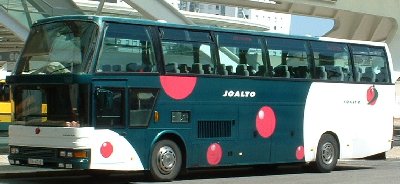
Joalto service at Oriente, June 2002.
4: Praça de Espanha
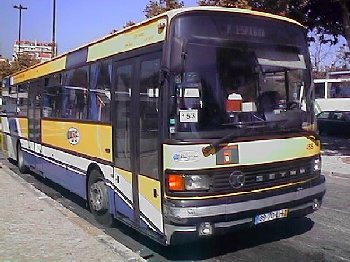
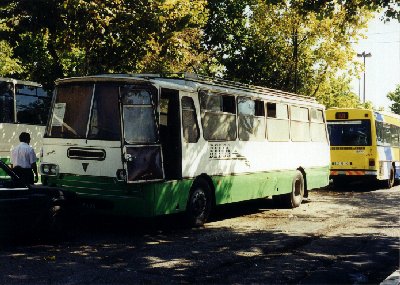
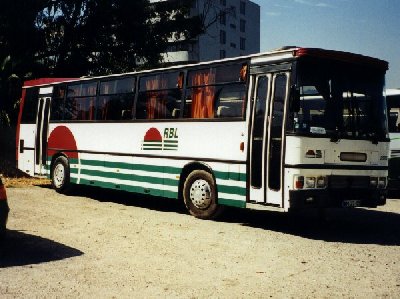
L to R: A TST service at Praça de Espanha; the Belos canteen bus used by Setubalense crews, an AEC-UTIC, fleet no.8442; an RBL (Coimbra) bus waits in the parking area.
Praça de Espanha is situated near the Metro station of the same name, some five
minutes walk from the Gulbenkian Museum amd Centro de Arte Moderna. It is a focus
for services primarily using the 25th April Bridge across the Tagus to towns
on the southern side of the river, including Setúbal. The main operators from here are Transportes Sul do Tejo (TST) (which since 2006 has incorporated the Setubalense company). Locations served include Setúbal, Elvas, Palmela, Corruche, Montijo, Almada and the Costa de Caparica. Apart from a few shelters and the unprepossessing booking kiosks of the operators, the Praça de Espanha bus station is lacking in facilities. As well as the bus stands, there is a large unmetalled section where out-of-service stock parks up.
5: The Former Arco de Cego Coach Station
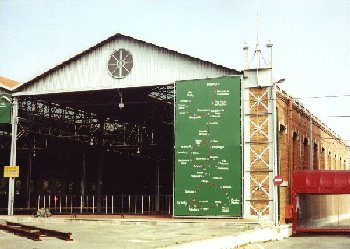
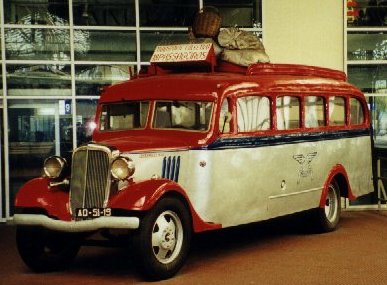

L to R: The main entrance to Arco do Cego coach station, with a short length of old tram track on the forecourt; a Chevrolet bus from the Algarve served as an exhibit at Arco do Cego; after closure Arco do cego has become a car park with an adjacent garden, as seen here in 2007.
Until September 2004, many long-distance coach services terminated inside the former Carris tram-sheds at Arco do Cego, which lie on the Avenida Duque de Ávila, near to Saldanha Metro station. Rede Expresso services covered most of the country, whilst operators such as Tejo and EVA also ran coaches from here. International services also operated, including an express service to Madrid. The outside of the building was adorned by eye-catching diagrammatic maps of nationwide coach services. Inside, there was an information desk, booking offices, a café and waiting areas. The former tram-shed and bus station building is now sadly a utilitarian car park whilst the outside coach-parking area has been converted into gardens.
6. Marquês de Pombal
Lisboa Transportes and VIMECA have ticket offices and operate a number of suburban services from the road which runs down the western side of the Parque Eduardo VII. These are chiefly commuter rather than tourist routes and destinations include Linda-a-Velha and Carnaxide. In summer 2005 this area was given over to major roadworks and buses had been moved elsewhere, in some cases slightly lower down the Avenida da Liberdade.
7: Algés Bus/Rail Interchange
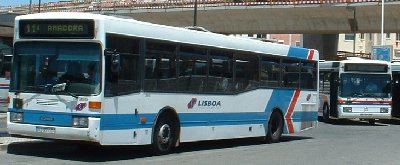
L to R: Lisboa Transportes SCANIA and a VIMECA Mercedes at Algés bus station, 2002.
Algés interchange is reached via the subway from the Algés
railway station, or by walking towards the coast from the tram #15 stop. It has
striking modern architecture but, unfortunately, the bus shelters are aligned
in such a way that they afford most protection from the sun for passengers
standing beside rather than under them. The bus station tower bears the name of Oeiras (the local administartive area) ratherv than of Algés itself. A five minute walk from here, along the inner coast road, away from Lisbon, is the Aquário Vasco da Gama which is well worth a visit. Amongst the bus operators to be seen at Algés are:
Lisboa Transportes
LT services are to be seen also at Belém and Marquês de Pombal. The fleet colour is a striking turquoise and white.
Vimeca- Viação Mecânica de
Carnaxide
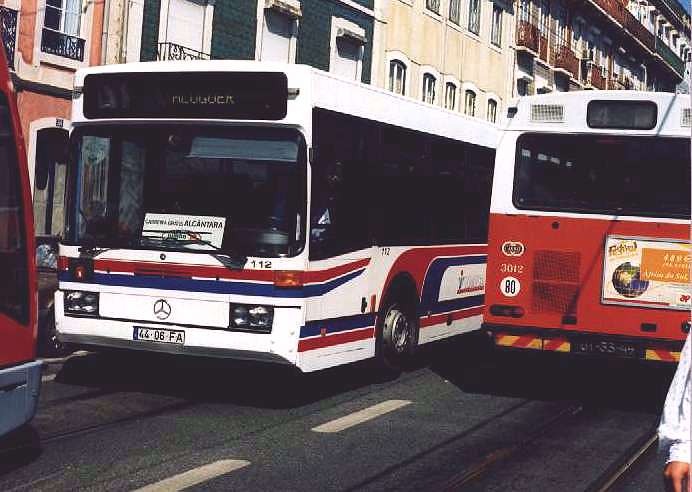
Vimeca Mercedes, no.112, out of service but stuck in a Belém traffic jam.
Formerly known as VMC, Vimeca operates services from Algés, using
a modern fleet of Mercedes vehicles. The livery is white, with blue and
red stripes. Headquarters are at Rua Marcos de Portugal, 2810 Laranjeira,
(tel: (01)253-20-57).
8: Estoril and Cascais Bus/Rail Interchanges
The bus station at Cascais is to the left of the station exit, alongside the railway
platforms on the seaward side of the station. The newish shopping centre on the landward side of the station (at the buffers-end of the station) has a cafe on the top floor with an open-air balcony which affords good views of Cascais train station and the adjacent road transport. The stops at Estoril are immediately outside the landward side of the station, towards the Lisbon end of the platforms. There is also a Scott URB information kiosk here. Across the road in the left arcade, adjacent to the Tourist Information Office is the Yate Bar which, with its neighbours, provides a good open-air vantage point.
Scotturb / Stagecoach Portugal
Scotturb, successor to Stagecoach Portugal, operates its modern fleet of buses largely to the west of the city centre, around Cascais, Estoril and Sintra. The company also runs a jointly
operated bus service with Rodoviária de Lisboa (Expresso 498) between
Cascais, Estoril, and the former Expo 98 site, now termed the Parque das Nações. Scotturb uses the Stagecoach livery of white, with orange, red and blue bands. Tel no: (01)-483-20-55.
For further details of the Sintra bus and tram services of Scotturb, visit this site's Sintra page.
9: Cacilhas Bus/Ferry/Metro Interchange
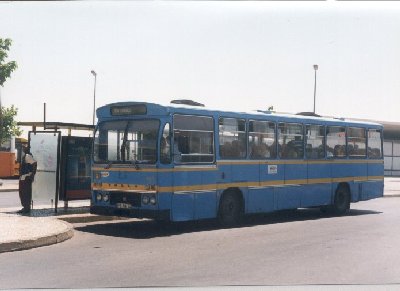
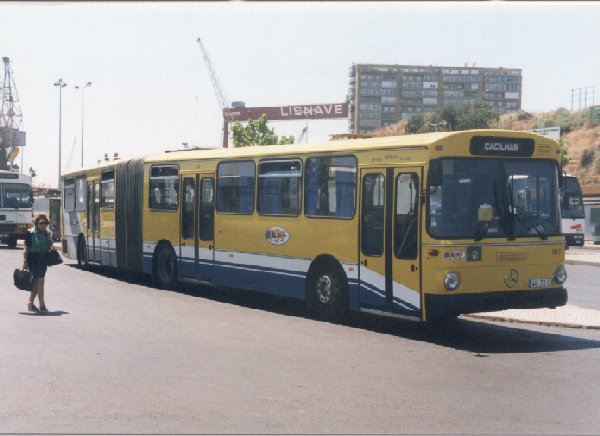
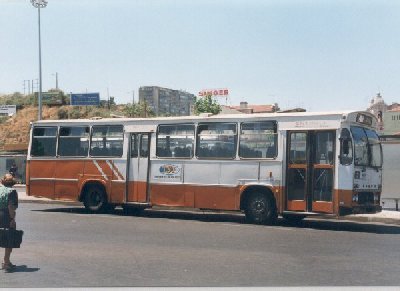

L to R: TST blue-liveried service to Caparica; TST yellow and blue flexibus at Cacilhas; TST bus in the old RN orange and white livery at Cacilhas- all seen in 1999. Far right: a 2008 view of a TST Scania, #561.
Cacilhas ferry terminal, a short ferry-ride across the River Tagus from either the Cais do Sodré ferry station, has a busy bus station immediately outside the ferry terminals as well as the MST tram terminal. Here can be seen numerous and varied vehicles from the TST (Transportes Sul Tejo) fleet and lesser numbers from other operators such as Setubalense. For ferry service details, see Lisbon Ferries page. In dry dock nearby are the former Navy sail ship D Fernanda e Glória and a submarine.
TST- Transportes do Sul do Tejo, S.A.
 TST services are particularly numerous at Cacilhas bus station, adjacent to the ferry terminal for services to Lisbon. Their fleet is in a variety of liveries, including blue and yellow and blue and white. Vehicles in the fleet include
flexibuses. Services include connections to the popular beaches of the Costa de Caparica.
TST services are particularly numerous at Cacilhas bus station, adjacent to the ferry terminal for services to Lisbon. Their fleet is in a variety of liveries, including blue and yellow and blue and white. Vehicles in the fleet include
flexibuses. Services include connections to the popular beaches of the Costa de Caparica.
A Coach Trips from Lisbon page is under development, indicating return trips that can be made from Lisbon in a day.
Copyright: ©
Contact: the following is not a link; please transcribe the address into your email 

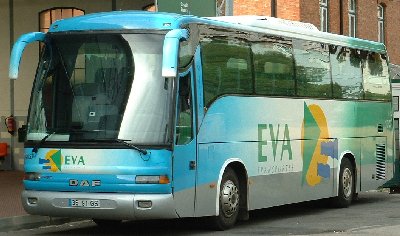
 28 June 2009 (in part)
28 June 2009 (in part)

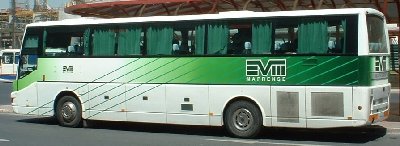


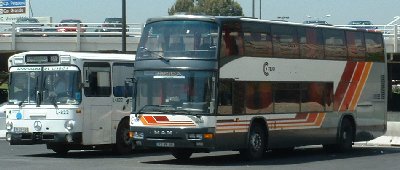















 TST services are particularly numerous at Cacilhas bus station, adjacent to the ferry terminal for services to Lisbon. Their fleet is in a variety of liveries, including blue and yellow and blue and white. Vehicles in the fleet include
flexibuses. Services include connections to the popular beaches of the Costa de Caparica.
TST services are particularly numerous at Cacilhas bus station, adjacent to the ferry terminal for services to Lisbon. Their fleet is in a variety of liveries, including blue and yellow and blue and white. Vehicles in the fleet include
flexibuses. Services include connections to the popular beaches of the Costa de Caparica.
